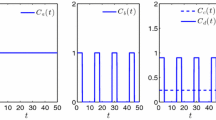Abstract
We consider a mathematical model for cancer chemotherapy with a single agent that distinguishes three levels of sensitivities calling the subpopulations ‘sensitive’, ‘partially sensitive’ and ‘resistant’. We analyze the dynamic properties of the system under what could be considered metronomic (continuous, low-dose, constant) chemotherapy and, more generally, also consider the optimal control problem of minimizing the tumor burden over a prescribed therapy interval. Interestingly, when several levels of chemotherapeutic sensitivities are taken into account in the model, lower time-varying dose rates as they are given by singular controls become a treatment option. This is only the case once a significant residuum of resistant cells has been created in a simpler 2-compartment model that only considers sensitive and resistant cells. For heterogeneous tumor populations, a more modulated approach that varies the dose rates of the drugs may be more beneficial than the classical maximum tolerated dose approach pursued in medical practice.




Similar content being viewed by others
References
André, N., Padovani, L., Pasquier, E.: Metronomic scheduling of anticancer treatment: the next generation of multitarget therapy? Future Oncol. 7(3), 385–394 (2011)
Bocci, G., Nicolaou, K., Kerbel, R.S.: Protracted low-dose effects on human endothelial cell proliferation and survival in vitro reveal a selective antiangiogenic window for various chemotherapeutic drugs. Cancer Res. 62, 6938–6943 (2002)
Bonnard, B., Chyba, M.: Singular Trajectories and Their Role in Control Theory. Mathématiques & Applications, vol. 40. Springer, Paris (2003)
Bressan, A., Piccoli, B.: Introduction to the Mathematical Theory of Control. American Institute of Mathematical Sciences, Springfield (2007)
Eisen, M.: Mathematical Models in Cell Biology and Cancer Chemotherapy. Lecture Notes in Biomathematics, vol. 30. Springer, Berlin (1979)
Friedman, A.: Cancer as multifaceted disease. Math. Model. Nat. Phenom. 7, 1–26 (2012)
Goldie, J.H.: Drug resistance in cancer: a perspective. Cancer Metastasis Rev. 20, 63–68 (2001)
Goldie, J.H., Coldman, A.: Drug Resistance in Cancer. Cambridge University Press, Cambridge (1998)
Greene, J., Lavi, O., Gottesman, M., Levy, D.: The impact of cell density and mutations in a model of multidrug resistance in solid tumors. Bull. Math. Biol. (2014). doi:10.1007/s11538-014-9936-8
Hahnfeldt, P., Hlatky, L.: Cell resensitization during protracted dosing of heterogeneous cell populations. Radiat. Res. 150, 681–687 (1998)
Hahnfeldt, P., Folkman, J., Hlatky, L.: Minimizing long-term burden: the logic for metronomic chemotherapy dosing and its angiogenic basis. J. Theor. Biol. 220, 545–554 (2003)
Hanahan, D., Bergers, G., Bergsland, E.: Less is more, regularly: metronomic dosing of cytotoxic drugs can target tumor angiogenesis in mice. J. Clin. Invest. 105(8), 1045–1047 (2000)
Kamen, B., Rubin, E., Aisner, J., Glatstein, E.: High-time chemotherapy or high time for low dose? J. Clin. Oncol. 18(16), 2935–2937 (2000), Editorial
Klement, G., Baruchel, S., Rak, J., Man, S., Clark, K., Hicklin, D.J., Bohlen, P., Kerbel, R.S.: Continuous low-dose therapy with vinblastine and VEGF receptor-2 antibody induces sustained tumor regression without overt toxicity. J. Clin. Invest. 105(8), R15–R24 (2000)
Lavi, O., Greene, J.M., Levy, D., Gottesman, M.M.: The role of cell density and intratumoral heterogeneity in multidrug resistance. Cancer Res. 73(24), 7168–7175 (2013)
Ledzewicz, U., Schättler, H.: Optimal bang-bang controls for a 2-compartment model in cancer chemotherapy. J. Optim. Theory Appl. 114, 609–637 (2002)
Ledzewicz, U., Schättler, H.: Drug resistance in cancer chemotherapy as an optimal control problem. Discrete Contin. Dyn. Syst., Ser. B 6, 129–150 (2006)
Ledzewicz, U., Schättler, H., Reisi Gahrooi, M., Mahmoudian Dehkordi, S.: On the MTD paradigm and optimal control for combination cancer chemotherapy. Math. Biosci. Eng. 10(3), 803–819 (2013)
Loeb, L.A.: A mutator phenotype in cancer. Cancer Res. 61, 3230–3239 (2001)
Martin, R., Teo, K.L.: Optimal Control of Drug Administration in Cancer Chemotherapy. World Scientific, Singapore (1994)
Norton, L., Simon, R.: Tumor size, sensitivity to therapy, and design of treatment schedules. Cancer Treat. Rep. 61, 1307–1317 (1977)
Norton, L., Simon, R.: The Norton–Simon hypothesis revisited. Cancer Treat. Rep. 70, 41–61 (1986)
Pasquier, E., Kavallaris, M., André, N.: Metronomic chemotherapy: new rationale for new directions. Nat. Rev. Clin. Oncol. 7, 455–465 (2010)
Pontryagin, L.S., Boltyanskii, V.G., Gamkrelidze, R.V., Mishchenko, E.F.: The Mathematical Theory of Optimal Processes. MacMillan, New York (1964)
Schättler, H., Ledzewicz, U.: Geometric Optimal Control. Springer, Berlin (2012)
Schimke, R.T.: Gene amplification, drug resistance and cancer. Cancer Res. 44, 1735–1742 (1984)
Swan, G.W.: Role of optimal control in cancer chemotherapy. Math. Biosci. 101, 237–284 (1990)
Swierniak, A.: Optimal treatment protocols in leukemia—modelling the proliferation cycle. In: Proc. of the 12th IMACS, vol. 4, pp. 170–172. World Congress, Paris (1988)
Swierniak, A.: Cell cycle as an object of control. J. Biol. Syst. 3, 41–54 (1995)
Swierniak, A., Smieja, J.: Cancer chemotherapy optimization under evolving drug resistance. Nonlinear Anal. 47, 375–386 (2001)
Acknowledgements
This material is based upon work supported by the National Science Foundation under collaborative research Grants Nos. DMS 1311729/1311733. Any opinions, findings, and conclusions or recommendations expressed in this material are those of the author(s) and do not necessarily reflect the views of the National Science Foundation.
Author information
Authors and Affiliations
Corresponding author
Additional information
This material is based upon work supported by the National Science Foundation under collaborative research Grants Nos. DMS 1311729/1311733. Any opinions, findings, and conclusions or recommendations expressed in this material are those of the author(s) and do not necessarily reflect the views of the National Science Foundation.
Rights and permissions
About this article
Cite this article
Ledzewicz, U., Bratton, K. & Schättler, H. A 3-Compartment Model for Chemotherapy of Heterogeneous Tumor Populations. Acta Appl Math 135, 191–207 (2015). https://doi.org/10.1007/s10440-014-9952-6
Received:
Accepted:
Published:
Issue Date:
DOI: https://doi.org/10.1007/s10440-014-9952-6




